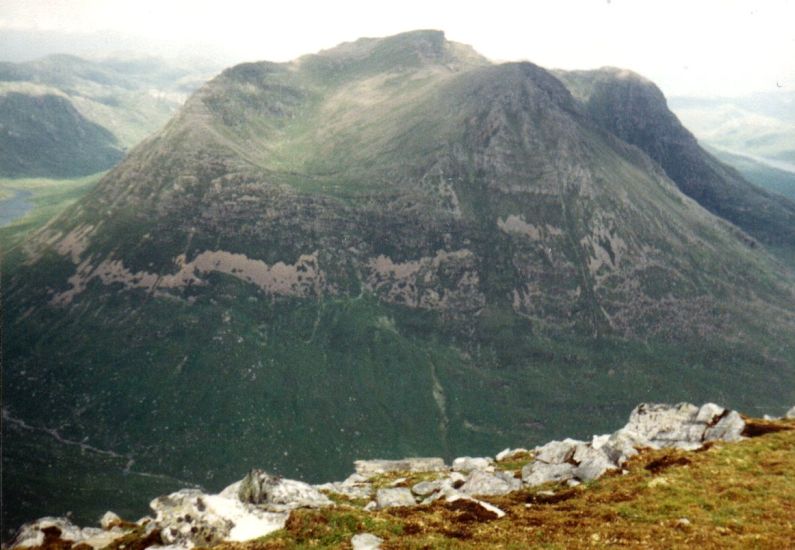

Many years venturing into the Scottish Highlands with repeated annual pilgrimages to favourite peaks such as Bidean nam Bian and Buchaille Etive Mor in Glencoe and Liathach and An Teallach in Wester Ross elapsed before I came across Munro's Tables - the primary target list for Scottish hillwalkers. The astonishing abundance and wide distribution of 3000ft summits throughout Scotland was a relevation and opened the window to many new areas never previously considered. Surprisingly many of the Munros are well within a comfortable day's outing while the appropriate and judicious use of bicycles, canoes and skis facilitates access to some of the more remote summits.
Nevertheless, the easy options eventually run out and to complete a round some long, hard-day's footslogging is then inevitable with 14 or more hours on the go involving total ascents and re-ascents amounting to some 10,000 feet - far harder than a typical day on trek in the Nepal Himalaya. However such long days dispense with the purgatory of carrying a heavy backpack of overnight camping and cooking gear for the multi-day expeditions that would otherwise be necessary.
The compensation obtained on these mammoth excursions is the satisfaction gained from collecting a fine bag of some of the best Munros and the enjoyment of some of the wildest and most spectacular of the Scottish landscapes.
One such long and demanding day and a considerable undertaking is the traverse of the Mamores with 10 major summits including the outlying Sgurr Eilde Mor. Although the main ridge rarely falls below the 2500ft contour, substantial diversions on subsidiary branches to An Gearanach and across the Bad Step on the Devil's Ridge to Sgurr a Mhain contribute significantly to the time and effort involved.
Another peak bagger's delight is the elevated Cluanie Ridge running along the south side of Glen Shiel with its seven peaks in seven miles giving fine views down into Glen Quoich and across to the Five Sisters of Kintail. On my traverse in an all-day deluge my new Goretex jacket proved its worth and was still functioning well some years later when I donated it on a trek in Nepal to my cook Lalu Limbu. "Water not coming," he happily pronounced as he tried it on in a monsoon downpour. All-weather clothing is an essential for tackling the Munros - to await forecasts of completely perfect days a round would never get completed.
Between Loch Monar and Loch Mullardoch a chain of four peaks extends deep into secluded, deserted teritory. Returning from the outermost, An Socath, late in the evening along the lochside I was horrified to find the way blocked by the Allt Taige burn in heavy spate. It seemed as if I had climbed almost back to the ridge-top before I managed to get across - a nasty sting in the tail of a tiring trip. Fording streams is one of the potentially fatal hazards of Scottish hillwalking.
 |
|
An
Socath, An Riabhachan and Sgurr na Laipaich above Loch Mullardoch |

Beinn Dearg Mor |
Ensconced beneath the mighty ramparts of An Teallach, the bothy at Sheneval can be used as a base to claim the six Munros embedded in the heart of a great wilderness area. However an early morning "alpine start" from the Dundonnel roadhead allowed me to complete a one-day circular tour of the six summits which provide some of the finest viewpoints of all the Munros. Perched on the nicely pointed, rocky top of A Mhaighdean, claimed by many to be the remotest Munro, a superb 360 degree panorama unfolds of the surrounding rugged mountain-landscape including an impressive outlook across Loch Fada to the imposing bastions of the fortress-like Slioch. A sensation of total isolation is experienced in the all-pervading silence.
The most adventurous, challenging and sporting of all the many possible of Scotland's high-level traverses is that of the seven-mile Sky-ridge with its 11 Munros including the Inaccessible Pinnacle - the most difficult of all the Munros and the greatest hurdle for most aspirant Munroists. Sustained scrambling is involved in negotiating the long, narrow arete with its rocky towers, gaps and sharp teeth. Although tedious and tiresome diversions on "tourist routes" are sometimes possible to bypass difficulties, rock-climbing equipment and experience are necessary for a strictly logical progression. Twenty hours is not unusual to complete the traverese while overnight bivouacs have sometimes been enforced on slowcoaches.
The Commentator, The ( Glasgow ) HERALD, Saturday 18th September 1999:
Southern Highlands :: Central Highlands :: NW Highlands :: Eastern Highlands